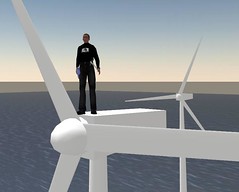
Following up on the premise of the ‘Virtual Architecture as the Ultimate Green‘ concept, I wrote some additional thoughts in a comment to a thread on the sustainability or ecological footprint of virtual worlds over at Clickable Culture, pasted below – originally written HERE. As the metaverse and the practice of architecture begin to converge, I think this topic will become increasingly valid.
“I am glad to see this conversation continue to surface!
I posed a similar question to the ‘Architects in SL’ group a few weeks ago, which turned into quite a passionate discussion.
We all agree on the need for a solid and verified base metric of the collective and individual metaversal footprint.
My feeling is that even a small percentage of physical presence transcending into a virtual mode would result in a significant net decrease in the overall footprint.
When you factor in the reduced transportation, the embodied energy of the materials required to build physical space as well as the energy required to constantly condition the air in that space, it seems likely that a virtual model for the same space would consume far less energy in the overall scheme of things.
As the technology evolves, I think it’s reasonable to assume that virtual interaction will actually become better, and more effective than certain types of physical interaction. Some might say it already is. If that’s true, and we start to see a more significant shift from bricks-and-mortar dependency into a more virtual mode, I’m confident the footprint balance would surely favor virtuality.
The metrics will be critical in helping us determine where that balance point lies. It needs to be very holistic in its consideration as well. For example, I would like to be able to understand how the footprint (including commuting, architecture, individual computers, and the office server)of a physical office of 50 people compares with that of 50 people working from home, not commuting long distances, still using individual computers, but accessing a sim server instead of their traditional office server. How would the two compare?
Obviously not every kind of physical interaction lends itself to virtuality. But when I think of the magnitude of even a small percentage of physical space, on a global scale, that could be accommodated virtually, I wonder if it could be the ultimate green – to not build anything at all.
I look forward to continuing this dialogue! “